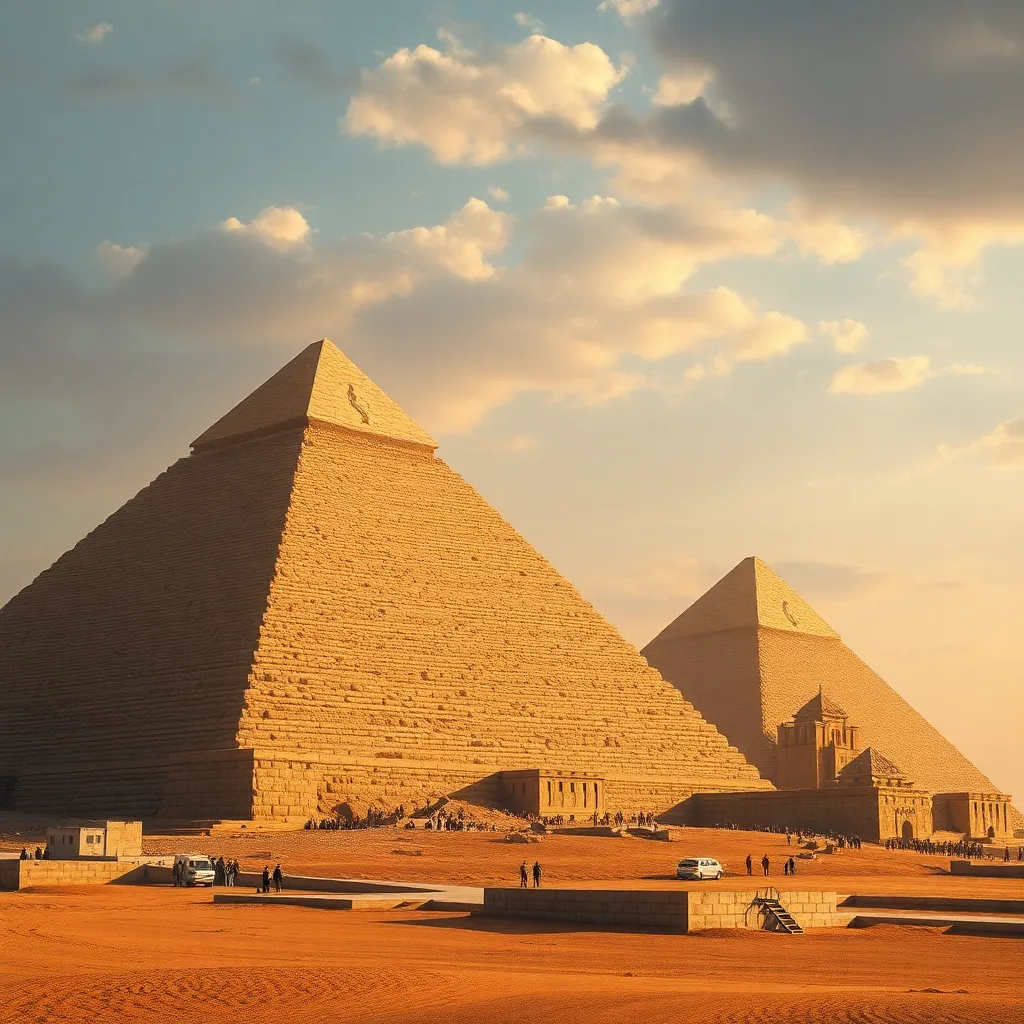The Pyramids and Their Role in the Afterlife Beliefs
I. Introduction
The pyramids of Egypt stand as some of the most iconic structures in the world, symbolizing the grandeur and mystery of Ancient Egyptian civilization. These monumental edifices were not merely tombs for the pharaohs; they were also integral to the Egyptians’ complex beliefs regarding the afterlife. In Ancient Egyptian culture, the afterlife was a critical aspect of existence, influencing art, architecture, and daily life. This article aims to explore the profound connection between the pyramids and the beliefs surrounding the afterlife in Ancient Egypt.
II. Historical Context of the Pyramids
The construction of pyramids spans several dynasties in Ancient Egypt, with the most famous examples found at Giza. The timeline of pyramid construction can be outlined as follows:
- Early Dynastic Period (c. 3100-2686 BCE): The emergence of royal tombs.
- Old Kingdom (c. 2686-2181 BCE): The age of the pyramids, marked by the construction of the Step Pyramid of Djoser and the Great Pyramid of Giza.
- Middle Kingdom (c. 2055-1650 BCE): Pyramid construction continues but with a shift to smaller structures.
- New Kingdom (c. 1550-1070 BCE): The focus shifts to hidden tombs in the Valley of the Kings.
Key pharaohs associated with pyramid construction include:
- Djoser: Builder of the Step Pyramid at Saqqara.
- Khufu: Builder of the Great Pyramid at Giza, the largest pyramid in Egypt.
- Hatshepsut: While not a pyramid builder, her mortuary temple reflects the significance of afterlife beliefs.
The evolution of pyramid design can be seen from the early step pyramids to the smooth-sided pyramids, representing advancements in architectural techniques and a deeper understanding of the afterlife.
III. The Pyramid as a Symbol of Ascension
The architectural design of the pyramids holds deep significance in Ancient Egyptian culture. The pyramid shape is believed to represent the rays of the sun, symbolizing the pharaoh’s ascension to the divine realm. The connection between the pyramids and the afterlife is evident in several ways:
- The sloping sides of the pyramid were thought to help the deceased pharaoh ascend to the heavens.
- Pyramids were often aligned with cardinal points and celestial bodies, reinforcing their connection to the cosmos.
This architectural symbolism reflects the Egyptians’ belief in a journey to the afterlife, where the deceased would be judged and, if deemed worthy, would live eternally alongside the gods.
IV. Burial Practices Associated with the Pyramids
Burial practices in Ancient Egypt were intricate and deeply rooted in their beliefs about the afterlife. Mummification was a crucial process, aimed at preserving the body for eternity. The significance of these practices included:
- Mummification: This process involved removing internal organs, desiccating the body with natron, and wrapping it in linen. It was believed that preserving the body was essential for the soul’s journey in the afterlife.
- Tomb Goods: Items such as jewelry, food, and tools were placed in the tomb to aid the deceased in the afterlife.
- Pyramid Complexes: These included mortuary temples where rituals were performed to honor the deceased and ensure their safe passage to the afterlife.
The pyramids thus served not only as tombs but as centers for worship and remembrance of the deceased pharaohs.
V. The Pyramid Texts: Insights into Afterlife Beliefs
The Pyramid Texts are among the oldest religious texts in the world, inscribed in the chambers of the pyramids. Their origin and purpose were to guide the pharaohs in their afterlife journey. Key themes found within the texts include:
- Invocation of Deities: The texts often call upon gods for protection and guidance.
- Rituals and Spells: Descriptions of various rituals designed to ensure the pharaoh’s successful transition to the afterlife.
- Cosmology: Insights into the Egyptians’ view of the universe and the afterlife, reflecting their beliefs in immortality and divine judgment.
The Pyramid Texts provide valuable insights into how the Ancient Egyptians viewed the afterlife and their expectations for the journey beyond death.
VI. The Role of the Pharaoh in Afterlife Beliefs
The pharaoh was considered a divine figure, a living god on Earth. His role in afterlife beliefs was paramount, as the stability of the kingdom was believed to depend on his successful passage to the afterlife. Key aspects include:
- Divine Status: The pharaoh was seen as an intermediary between the gods and the people.
- Journey to the Afterlife: The pharaoh’s journey was laden with challenges, requiring protection and guidance from deities.
- Immortality: The construction of pyramids was believed to ensure the pharaoh’s immortality and continued influence over the living.
Thus, the pyramids served as monumental statements of the pharaoh’s power and a means to secure his eternal legacy.
VII. Cultural Legacy and Modern Interpretations
The fascination with the pyramids continues in contemporary culture, symbolizing mystery and human ingenuity. Modern archaeological discoveries have shed light on the complexities of Ancient Egyptian afterlife beliefs, including:
- Uncovering hidden chambers and tombs that reveal burial practices.
- Insights into the daily lives of the builders, which highlight their devotion and beliefs.
- Technological advancements that allow for non-invasive exploration of pyramid structures.
The impact of the pyramids extends into modern spiritual and religious thought, inspiring various interpretations of life, death, and the afterlife across cultures.
VIII. Conclusion
In summary, the pyramids of Egypt are not only architectural marvels but also profound representations of Ancient Egyptian beliefs about the afterlife. These structures encapsulate the spiritual significance that shaped the society, influencing everything from governance to daily life. The lasting legacy of the pyramids continues to inspire awe and curiosity, serving as a testament to the Ancient Egyptians’ quest for immortality and connection with the divine.




